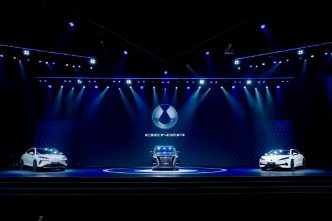Chinese electric vehicle (EV) manufacturer BYD reported an 11.5% increase in net profit for the third quarter on Wednesday, reaching 11.6 billion yuan ($1.63 billion), as strong sales were bolstered by national trade-in incentives and regional subsidies supporting EV adoption.
The company’s revenue for July-September rose 24% year-on-year to 201.1 billion yuan ($28.24 billion), exceeding Tesla’s revenue for the same period at $25.2 billion, according to BYD’s stock exchange filing.
A significant portion of BYD’s sales growth was driven by the company’s latest plug-in hybrid models, with sales jumping 75.6% year-on-year to 685,830 units in the third quarter.
Pure electric vehicle sales, however, showed slower growth, with a 2.7% increase to 443,426 units. In response to mounting competition in the pure EV market, BYD has focused on increasing its plug-in hybrid offerings, which aim to provide “more fuel cost savings for users,” the company said.
Government incentives have played a notable role in supporting BYD’s growth, as nationwide trade-in subsidies, allowing consumers up to $2,800 for switching to greener vehicles, continued to encourage demand. According to official data, over 1.57 million applications had been filed for the subsidy by late October.
Local governments have also added up to 20,000 yuan in incentives for EV buyers, a program expected to conclude by year-end. Benefiting from this favorable policy environment, BYD reached record monthly and quarterly sales levels in September, helping to lift overall EV and plug-in hybrid sales in China after a five-month sales decline.
BYD, which exports approximately 10% of its vehicles, is also expanding internationally despite facing new tariffs in Europe. Overseas sales grew 32.6% to 94,477 vehicles in the third quarter. Aiming to double its exports to 450,000 vehicles this year, BYD has adjusted its target downward from 500,000, set in March, according to industry analysts.












